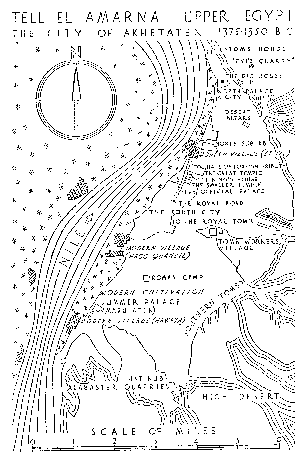Dreams of Amarna – Approaching The Final Decision on the Map
You may recall that the first large element of the panels for Dreams of Amarna that I am stitching is a map of the site shown in Mary Chubb’s book.
It was easy to decide that I wanted to use reverse herringbone stitch for the contours of the high ground around the site, and unbroken lines of chain stitch for the Nile.
The compass rose and the titles were more difficult, although I made a decision eventually.
Now, however, I am near to finishing the text, and I can’t really put off my final decision any longer.
Areas of cultivation are shown on the original map using stars drawn roughly using four strokes. The obvious choice is to use Star Stitch, which exactly replicates the symbol used by the cartographer, but I don’t want to do that.
The aim of my stitching is not to reproduce a painting or a drawing, or even to reproduce those effects. I want to use embroidery techniques to produce impressions and effects that couldn’t be produced any other way, but that are inspired by the subject.
Tricky.
I finally settled on a stitch, after considerable thought and several hours leafing through my (never-ending shelf of) embroidery books – tête de boeuf stitch. But I’m still trying to work out what thread to use, and at what scale. So I’ve worked several test patches, and when I’ve finished the other stitching (the text and the villages), I’m going to wash and iron the whole thing and then sit back and look at them for a while…


I always find the script the most difficult to stitch in such a way that it doesn’t take over the whole design or become messy or just frustrate me.
I have never used that stitch and will be interested to see your samples.
As I was reading your blog, I thought single wheatear stitches might be nice. Then I read that you had settled on tête de boeuf stitch. I didn’t know what the was so clicked on your link and had to smile when I saw something remarkably similar to single wheatear stitches. Great choice!
I started my snail the night before last – he is soooo cute 🙂
Oh yes, that tête de boeuf stitch looks perfect. At any rate it looks nothing like la tête d’un boeuf! I do agree with you about using embroidery techniques to produce impressions and effects that couldn’t be produced any way other than by embroidery. For me, that’s where a lot of embrodery designs fall down. They try to reproduce a photographic or painted image.
Wow – you’re going to sew that? Amazing!
What a fascinating project this will be. I agree with Janice entirely – the whole point of embroidery is that it’s not drawing, painting or photography. Will be very interested to see how you interpret this.
A friend of mine stated while teaching a landscape class….. you want to make the same impression not an exact replicate. Oh, and BTW, I love the idea of the t’ete de boeuf they look like wheat in the golden brown color.
The stitch you selected will be perfect! This is quite an impressive undertaking and I’m glad to see your progress. And I love all the history you impart along the way.
[…] villages on the Map, I need to decide what to use for the cultivation… You may recall from my earlier post that I have decided on the stitch I’m going to use – tête de boeuf stitch – but […]